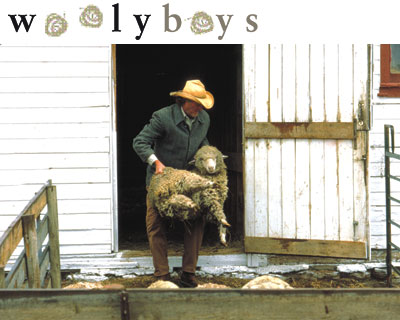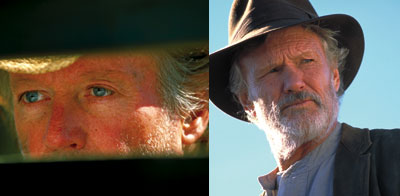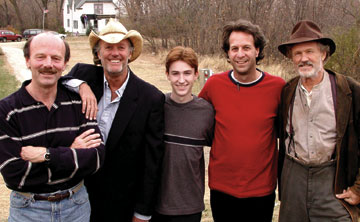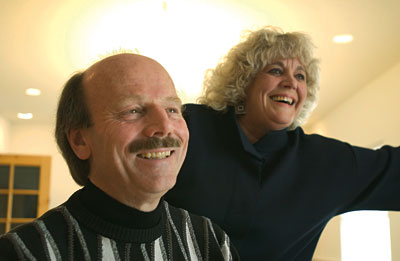
Ken Promersberger is not your typical Hollywood movie mogul. No stretch limo, sunglasses or discernible suntan. He's just sort of a down-to-earth North Dakota kind of guy, born and raised in Fargo, married for 34 years to his college sweetheart.
Yet just a couple of months ago, a bonafide Hollywood movie, the first one ever to be filmed in North Dakota, complete with major stars, was released to an enthusiastic audience. Prominently displayed among its credits was "Executive Producer -- KEN PROMERSBERGER."
How did that all happen to come about? Well, not surprisingly, it's a moderately long, fairly complicated story.
You have probably had the experience of sitting through a movie you didn't particularly care for. On such occasions you may have caught yourself thinking, you could make a movie, maybe even a better movie.
But, by the time you've hung around long enough to read several yards of credits at the end -- the "best boy," "key grip" (whatever that is), the "rattlesnake wrangler," "personal assistant to Mr. Second Banana" and the crew that filmed part of it in Bosnia, you were forced to admit that making a major motion picture involves quite a bit more than simply having a good idea.
For starters: a fairly staggering amount of money -- even for a so-called low-budget film; a sizable collection of probably over-paid, self-important, temperamental human beings; and a degree of managerial skill on a par with what it took Dwight D. Eisenhower to orchestrate the D-day invasion, not to mention roughly enough lawyers to populate a medium-sized North Dakota town. Those are just a few of the things it takes to pull off making a major motion picture in the hope of ending up with an acceptable product. And even at that point, it's still a major gamble.

For those of us still in relatively full possession of our faculties, that would be enough to convince us it's much too daunting a project on which to embark. Apparently not Ken Promersberger.
"It was back in the late 1980s," he recalls. "I had this idea for a movie I couldn't seem to get out of my head. It was a 'whodunit' (tentatively called 'Second Rising,') involving U.S./Japanese cultural and economic conflicts ... back when there was a lot of Japan bashing going on in America."
As is often the case with wives, Ken's wife and long-time business partner, Jan (Workman, a 1964 graduate of North Dakota State University), was getting tired of hearing about it. "Either do something about it or forget the whole idea!" she advised.
Luckily for Ken at the time, Minnesota had an independent film organization that put him in touch with a guy named Robert Schwartz. Schwartz knew his way around Hollywood and quite a bit about the nuts and bolts of film production and was willing to share that knowledge. He also had advice on how to go about dipping one's toe into the maelstrom of Hollywood film production.
Without going into elaborate detail, the Japan idea flopped. Just about the time he and Schwartz were putting finishing touches on the screenplay, well-known author Michael Crichton came out with a book about Japan titled "The Rising Son," which trumped what they had thought was a good idea. But that minor bump in the road failed to dampen their enthusiasm for collaborating on a film.
NDSU alumni who attended Fargo's Agassiz Junior High back in the 1960s will remember a classy director/composer of band music for high schools named James Ployhar. Ployhar, it turned out, owned a screenplay about a 1917 dogsled race from Winnipeg to the St. Paul Winter Carnival (via Fargo and over some strangely situated mountains). The work of a veteran screenwriter John Michael Hayes, who had previously done scripts for "Rear Window" and "To Catch a Thief," it appealed to Promersberger, who passed it on to Schwartz. With a bit of financial encouragement, Schwartz pitched it to the Disney organization, which filmed it (mostly in Duluth), and titled it "Iron Will."
Most people who saw "Iron Will" liked it quite a lot. Unfortunately, the week of its premiere, New York City and much of New England went into a deep freeze, and California had an earthquake. Still, the movie did well at the box office and Ken's career as a movie mogul was off to a running start. That's roughly how the Hollywood phase of his career began.

These days, Ken and Jan's day job, the Promersberger Company, an advertising agency with a professional staff of 12, operates out of a very un-Hollywood setting. Rocking Horse Farm, as they have named it, consists of a rather lonesome-looking office building, deliberately designed to have the outward appearance of a North Dakota barn and silo, located on 235 acres of a treeless, windswept, flat-as-a-pancake Red River Valley farmland on the southwest edge of Fargo.
Although its outside appearance is deceptive, Rocking Horse Farm's principal structure (there are more in the plans for the years ahead) is actually a very classy, state-of-the-art office building, complete with a kitchen that produces daily batches of chocolate chip cookies and occasional lunches for office visitors and staff. Architect Terry Stroh, a 1980 graduate of NDSU, designed the place.
Now into the fourth decade of its existence, the Promersberger Company has a well-established reputation for handling major national accounts for construction and industrial equipment manufacturers, agricultural marketing firms (Mitsubishi Engines and Toro, for example) attested to by a wall of plaques and framed certificates representing honors the agency has won.
Of course it hasn't always been like that. (We warned you this was going to get a little complicated). For roughly the first decade of their marriage/partnership, Ken and Jan's lives followed a pattern that will have a familiar ring for many fellow baby boomers -- two years in grad school, two kids, three years in the Air Force. Out of the service, Ken took a job doing publicity for a California home builder. They came back to Fargo in the 1970s. Ken helped his dad, Bill (long-time head of ag engineering at NDSU) build the family a Minnesota lake home, then built a speculation house in Fargo, which they lived in and used as an office until it was sold, a calendar year from the day it was finished. That sort of thing.
Looking back, Jan, a phy-ed major at NDSU, claims she doesn't recall applying for the job that evolved into a full partnership in the advertising business with her spouse. With his involvement in the film and the Rocking Horse Farm development, she, according to Ken, "really runs the agency now."
Operating their business out of an extra bedroom produced quite a few fond, and some not-so-fond, memories:
- Their sole initial office equipment inventory: an IBM Selectric Typewriter and a bag of nickels with which to feed the Xerox machine in the NDSU Library.
- Their bedroom/office, with clothes stored in a couple of Chiquita Banana boxes under the bed.
- Answering an insistent, early morning knock on the door in bathrobe, slippers and pajamas to be greeted by a toothy white-suited television advertising salesman.
It was a pretty hand-to-mouth operation in those days -- helping someone design a sales brochure, doing part-time PR work for an architect, and launching Home Magazine, (with the help of Jim Bakken, '71, and Marilyn Mathison Anstett, '68) to promote F-M real estate, home construction and decorating.
Corporate headquarters for the magazine was a thin-walled structure in Fargo's Industrial Park, directly under the flight path at Hector Airport and next to a heavily traveled set of railroad tracks. "Every time a Happy Hooligan decided to blow the soot out of his fighter jet, we had to give up trying to talk on the telephone," Promersberger says. "My desk was a 4' x 8' sheet of exterior-grade plywood on a couple of sawhorses. It left snags across the front of all of my polyester pants. One time the building shook so hard when a train went by that an X-acto knife rolled off the drawing board of one of our hippie-type, barefoot designers and sliced into his foot."
Although he had sampled engineering and architecture early in his academic career, Promersberger decided the business world beckoned more enticingly. Unfortunately, NDSU didn't offer a major in business back then. His interest in the business aspects of mass communications was piqued by a part-time job in the university news bureau and one selling advertising for The Spectrum under his friend and classmate Dave Herstad, a 1963 graduate, who was the business manager. Fairly late in their undergraduate years, the two launched a syndicated clip-art service specifically targeted at college and university student newspapers. Although they got an encouraging response from quite a few papers, their enthusiasm for running the business waned as graduation neared. That's pretty much how it all began.

It is now the mid-1980s. Things are going well at the Promersberger Company and Rocking Horse Farm. Perhaps it's time to sit back and rest on one's laurels. But, encouraged by the success of "Iron Will," there is the nagging compulsion to consider making another film.
In 1993, again in partnership with Robert Schwartz, who became the film's producer, the Promersbergers purchased an option on the screenplay for "Wooly Boys." A team of writers had done the first draft. Feeling it needed additional work, they hired a second screenplay-writing team to make some changes. Ken modestly admits to suggesting the inclusion of the teenage city boy character, and it's a little hard to picture what the film would have been like without him.
"We spent three years on the creative aspect of it," Promersberger says, "and four years coming up with the financing." Total cost of the production runs to $4.1 million, a substantial amount of which came from 13 private investors, all but one of whom are North Dakotans, with further financial underwriting from the State Bank of North Dakota.
After nearly a decade of hard work and preparations, "Wooly Boys" was filmed in the North Dakota Badlands, in 27 working days, during October 2000.
Jan recalls thinking at the time, "It's going to be sheer pandemonium out in Medora when all of those people show up." Oddly enough, it wasn't. Eighteen semis and a crew of more than 100 rolled into the tiny restored North Dakota town. "They all had jobs that they knew how to do. They went right to work and did them. It was amazingly well disciplined and organized."
In a nutshell, "Wooly Boys" is a story about a pair of scruffy-looking sheep ranchers played by veteran Hollywood actors Peter Fonda and Kris Kristofferson and a young, "over-protected, over-programmed" (from growing up in the city) teenager played by 17-year-old Joe Mazzello (of Juraissic Park fame). Mazzello plays the Fonda character's grandson. The plot pretty much involves a coming-of-age experience for the young guy in the company of his grizzled companions. A third Hollywood veteran, Keith Carradine, plays the local sheriff. Much of the film is beautifully photographed in the nearby North Dakota Badlands.
Because the interior of a real log cabin offers far too little space in which to shoot the interiors of a Hollywood movie, a replica was constructed in the gym of abandoned Fryburg High School. Art ('52) and Norene Bunker came to the rescue, providing for the construction costs. The former high school made a perfect mini film studio, with the producer taking over the principal's office and classrooms providing dressing rooms and other needed space.
Both Ken and Jan had nothing but high praise for the film's several stars. "They seemed to feel right at home in the Badlands. Fonda and Kristofferson were comfortable, seasoned performers." Fonda later described the 17-year-old Mazzello as "the best actor in the bunch." Veteran Hollywood director Leszek Burzynski and his crew captured the story and the beauty of the North Dakota Badlands with skill and sensitivity.
Promersberger is quick to acknowledge that "Wooly Boys" was never intended to be an art film, just, he hopes, "good entertainment," that he describes as a "comedic, heartwarming adventure," for which there is a market. Initial reaction to the film's debut was "beyond our wildest expectations." It grossed nearly $10,000 per screen in five theaters across North Dakota and finished second highest among 106 films playing in America that week. The Minneapolis StarTribune gave it three of a possible four stars in its review, and box office numbers continued to hold up well during the second week (a rarity among Hollywood films).
At this writing, "Wooly Boys" had yet to be released to a national/international market, clearly the true test of its ultimate success.
Now that Cecil B. Promersberger has experienced both the joys and agonies of making a Hollywood film, are there other such projects in the works? Robert (Schwartz) and Promersberger own two other screenplays, and are looking at others. "The screenplay is what sells the project. Without a great screenplay, we never would have gotten talent of this caliber on either the cast or the crew."
-- Jerry Richardson

































